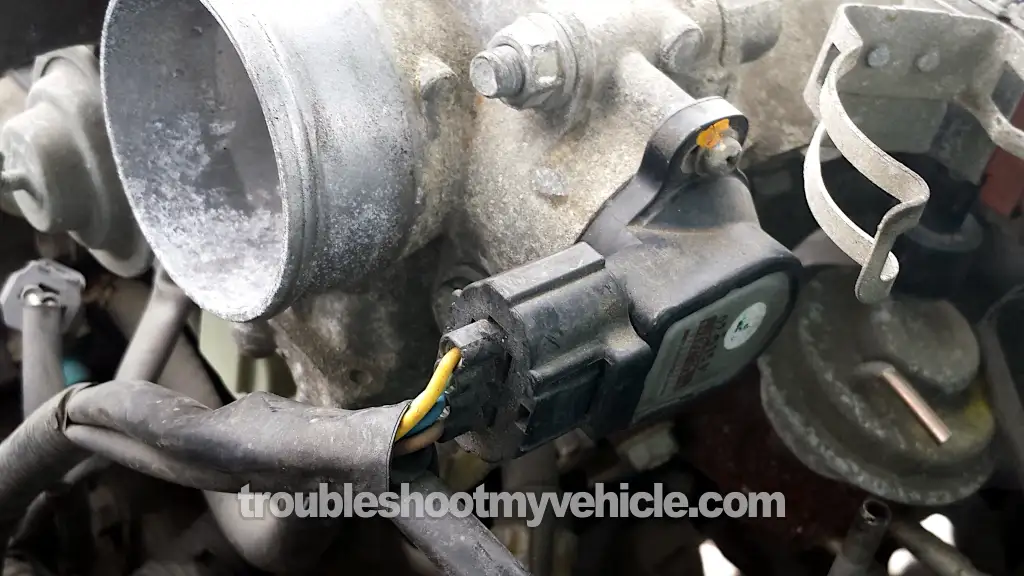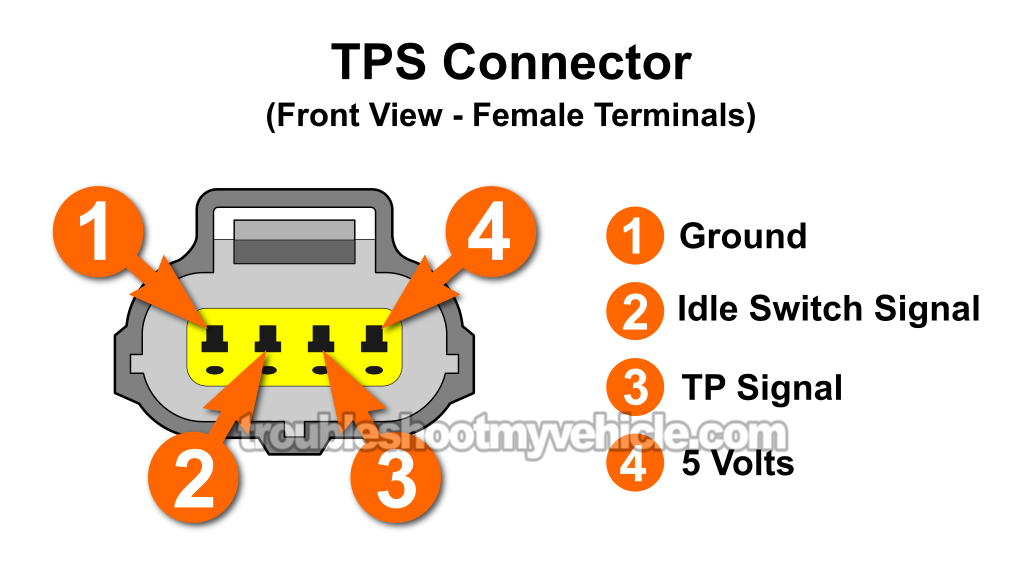
In this tutorial, I'm gonna show you how to check the throttle position sensor (TPS) on the 1993-1997 1.8L Toyota Corolla using just a multimeter -no scan tool required.
With your multimeter test results, you'll quickly and easily figure out if the TPS is faulty or working fine.
NOTE: The throttle position sensor assembly used on the 1993-1997 Toyota Corolla (and the 1993-1997 Geo Prizm) has two parts. One side is the TPS itself, while the other is an idle switch. Here, we're only focusing on testing the TPS.
If you need to test the idle switch part of the TPS, this tutorial will help: TPS Idle Switch Multimeter Test (1.8L Toyota Corolla).
Contents of this tutorial:
- What Does The Throttle Position Sensor Do?
- Symptoms Of A Bad Throttle Position Sensor.
- Where To Buy The Throttle Position Sensor And Save.
- TEST 1: Testing The Throttle Position Sensor Voltage Signal.
- TEST 2: Verifying Throttle Position Sensor Has Power.
- TEST 3: Verifying Throttle Position Sensor Has Ground.
- More 1.8L Toyota Corolla Tutorials.
APPLIES TO: This tutorial applies to the following vehicles:
- 1.8L (7A-FE) Toyota Corolla: 1993, 1994, 1995, 1996, 1997.
- 1.8L Geo Prizm: 1993, 1994, 1995, 1996, 1997.
What Does The Throttle Position Sensor Do?
The throttle position sensor (TPS) is a key part of your Corolla's engine management system. It tells the fuel injection computer how much the throttle plate is opening or closing. This information is crucial for adjusting fuel injection and ignition timing as the engine runs.
This particular TPS is a bit unique because it also has an integrated idle switch. This switch tells the ECM when the throttle is fully closed, helping regulate idle speed and fuel delivery when the engine is idling.
Here's a breakdown of what the TPS does:
- Idle Position: The idle switch inside the TPS signals the ECM that the throttle is fully closed. This helps control idle speed and fuel mixture for smooth idling.
- Part-Throttle: As you press the gas pedal, the TPS sends a varying voltage signal to the ECM, letting it know how much air is entering the engine. The ECM then adjusts fuel injection and ignition timing accordingly.
- Wide Open Throttle (WOT): When you floor the gas pedal, the TPS signals the ECM that maximum acceleration is needed. This triggers more fuel injection and adjusts ignition timing for better performance.
In short, the TPS helps ensure smooth acceleration, efficient fuel delivery, and stable idling. If it malfunctions, you might experience rough idle, poor acceleration, or even a check engine light.
Symptoms Of A Bad Throttle Position Sensor
Your 1.8L Toyota Corolla (or Geo Prizm) comes with either an OBD I or OBD II fuel injection system, depending on its year. Both On-Board Diagnostic (OBD) systems are built to trigger a TPS trouble code when the sensor stops working.
Here's a quick rundown of the symptoms you might notice when it fails:
- Check engine light (CEL): The CEL will illuminate when the fuel injection computer detects a throttle position sensor (TPS) issue and registers a diagnostic trouble code (DTC).
- A stored TPS trouble code in the PCM's memory:
- Code 41: (OBD I) Throttle Position Sensor Circuit Malfunction.
- P0120: (OBD II) Throttle Position Sensor Circuit Malfunction.
- Bad gas mileage: A failed TPS triggers "limp-in" mode, disabling the fine-tuning of the air/fuel mixture. As a result, more fuel is injected into the cylinders, reducing fuel efficiency.
- Hard to start: The engine takes longer to crank before it finally starts.
- Black smoke: A bad TPS often causes a rich air/fuel mixture, leading to excess fuel burning in the cylinders. This results in black smoke coming from the exhaust.
- Hesitation: When you step on the gas, the engine may momentarily lose power before accelerating.
Where To Buy The Throttle Position Sensor And Save
You can buy it at your local auto parts store but it's gonna cost a whole lot more. I suggest taking a look at the price of the TP sensor in the following links and compare:
Disclosure: As an Amazon Associate, I earn from qualifying purchases. If my tutorials help you, using these links is an easy way to support the site at no extra cost to you. Thank you!
Not sure if the above TP sensor fits your particular 1.8L Toyota? Don't worry, once you get to the site, they'll make sure it fits by asking you the particulars of your vehicle. If it doesn't fit, they'll find you the right one.
TEST 1: Testing The Throttle Position Sensor Voltage Signal

The TP sensor's job is to measure the angle of the throttle plate as you step on or release the accelerator pedal. As the throttle angle changes, the TPS converts it into a voltage signal.
Here's how it works:
- Signal voltage increases: This output happens only when you step on the accelerator pedal and the throttle plate opens.
- Signal voltage decreases: This happens when you step off the accelerator pedal and the throttle plate closes.
This predictable voltage change makes it easy to test the TPS with a multimeter and confirm whether it's working properly.
Here's what we're looking for:
- Good TPS: Voltage signal increases/decreases as the throttle plate opens/closes.
- Bad TPS: Voltage signal does NOT change as the throttle plate moves.
IMPORTANT: This test has to be done with the TPS connected to its electrical connector. To access the signal within the wire, you'll need to use a back probe or a wire-piercing probe. You can see an example of this tool here and where to buy it: Wire Piercing Probe (at: easyautodiagnostics.com).
This is what we need to do:
- 1
Set your multimeter to Volts DC mode.
- 2
Take the red multimeter test lead and connect it to the middle wire on the sensor's connector.
This wire corresponds to the pin #3 in the illustration above. - 3
Attach the black multimeter test lead to the battery's negative (-) terminal.
- 4
Ask your helper to turn the key to the ON position, but don't start the engine (this powers up the TP sensor).
- 5
Your multimeter should show a voltage between 0.2 and 0.9 Volts DC. If it doesn't, don't stress over it yet —just move on to the next steps.
Part 2
- 6
Slowly open the throttle by hand (from the engine bay) and keep an eye on the voltage readings.
For an accurate test, make sure to move the throttle manually instead of using the gas pedal inside the car. - 7
Watch as the voltage increases when the throttle opens.
The voltage rise should be steady, with no sudden drops or gaps. Once the throttle is fully open, your multimeter should read somewhere between 3.5 and 4.5 Volts DC. - 8
Slowly close the throttle. As it shuts, the voltage should decrease smoothly, landing back at the exact reading you got in step 5, with no glitches or skips.
Part 3
- 9
Gently tap the throttle position sensor with a screwdriver handle (or something similar—remember, just a light tap) while slowly opening and closing the throttle. Keep an eye on the multimeter.
If the TPS is faulty, tapping it will cause voltage readings to jump around or momentarily disappear. If it's in good shape, tapping won't affect the voltage at all. - 10
Do step 9 a few times to confirm your test results.
Let's go over what your test results mean:
CASE 1: The voltage went up when you opened the throttle and dropped when you closed it. That means the TP sensor is working fine and isn't faulty.
CASE 2: The voltage didn't change when you moved the throttle plate. This points to a problem with the throttle position sensor (TPS) on your Corolla.
Before deciding the TPS is junk, you've gotta make sure it's getting both power and Ground. To check if power is reaching the sensor, head over to: TEST 2: Verifying Throttle Position Sensor Has Power.
CASE 3: The multimeter didn't show any voltage at all. This doesn't automatically mean the TP sensor is bad.
Why not? Because the issue might be a missing power or Ground connection. Your next step is to confirm whether the TPS is getting power. Go to: TEST 2: Verifying Throttle Position Sensor Has Power.


